Ethnic Groups in Iran
The Iranian nation is but a single nation. Still and all, some cultural diversities can be seen. However, these diversities have common cultural, linguistic, historical, and mythological roots, making it impossible to account for them as separate forms of civilizations.
The history of the Iranian tribes and nomads represents the history of Iran. In 1921, nomads inhabited 25% of the population. As for today, the numbers have dropped to 2%.
The Iranian tribes, throughout history, had political power for the two following reasons:
- Their unquestioned obedience to the leader of the tribe
- Being fully armed which was a necessity for their survival
The majority of the population of the Ethnic groups in Iran is located in an area of about 963 thousand square kilometers (60% of Iran). They have access to 450 thousand hectares of land for agricultural and 20 thousand hectares of Arboretum (Botanical gardens). As one of the most important poles of Iran’s production system, they produce more than 300 thousand types of handicrafts with more than 12 billion Tomans (the current currency of Iran) of overall profit. On top of all that being said about the numerous potentials of Ethnic groups in the country in the production of consumer goods and necessary industries, there also exist the touristic, cultural, and anthropological attractions related to these groups. These potentials have not yet been taken into consideration.
The Touristic Attractions of Ethnic groups in Iran
Nomadic tourism plays the most important role in anthropology Tourism. Despite all the difficulties behind the nomadic lifestyle, it is still the chosen lifestyle of thousands of families. With a closer look, the original and rich culture of this part of the society could prepare a vast ground for admirers of Art and Culture along with researchers of various academic majors. International poles of Touristic attraction of Ethnic groups:
- Local and regional linguistic
- Traditional and indigence housing
- Clothing and apparel
- Customs, celebrations, and rituals
- Handicrafts
- Farming techniques
- Music
- Traditional technology
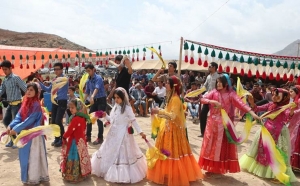
How Many Ethnic Groups are in Iran?
Iran is one of the most diverse and multi-ethnic nations in the world. Ethnic groups occupy more than half of the country. Overall, there are 12 well-known ethnic groups in Iran. However, in the heart of these ethnicities, there are several tribes and nomadic cultures. The ethnic groups include:
1. Persians
There was a time that Iran was called Persia. Accordingly, the people of Persia regardless of their ethnicity were called Persians. However, it is not as simple as that. Today, he term Persian refers to an ethnic group that speaks the dialect of Persian and live in the modern regions of the country of Iran. Ethnic Persians inhabit the main provinces of the country of Iran.
2. Azeris
Azeris are the second largest ethnic group in Iran, after Persians. They mainly live in the northwest regions of the country, such as East and West Azerbaijan, Ardabil, Zanjan, and parts of Kurdistan. Azeris speak a Turkic language called Azerbaijani or Azeri, which is closely related to Turkish.
3. Turkmens
Turkmens are one of the largest ethnic minorities in Iran, mostly living in the northeastern provinces of Golestan and North Khorasan. They are descendants of Turkic tribes that migrated to Iran from Central Asia centuries ago and have preserved their distinct culture, language and traditions. This ethnicity consists of different tribes. The tribes include Yamut, Teke, and Koklans. Overall, Turkmens are settled in Turkmen Sahara along the northern border of Iran and the provinces of Mazandaran and Khorasan. The roots of this ethnicity go back to Central Asia. Aside from Iranian Turkmen and their tribes, there are also the Qashqai tribe and nomadic group. The Qashqai mainly live in Fars province, Khuzestan, and parts of Isfahan province. They were originally pastoral nomads which adds much more to the importance and attraction of this ethnic group.
4. Kurds
The Kurds are an ethnic group that live in several countries in the Middle East, including Iran. They have their own language, culture, and history. Iranian Kurds live mostly in the western part of the country. Accordingly,
they live mostly along the great Zagros Mountain. This mountain range stretches from the south of Baku in Azerbaijan to northern Lorestan and Khuzestan Province in Iran. In the middle east and west Asia, this ethnicity lives in southeastern Anatolia, northern Iraq, northeastern Syria, and Armenia. The Kurds were originally Nomads. That is what the Kurdish traditional lifestyle is one of the most unique lifestyles that you can see in Iran. The Kurds consist of different tribes and varieties of the Kurdish language. For more information about Kurd Ethnicity and other ethnicities, you can check out our blog.
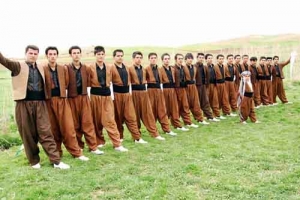
5. Lurs
Another unique ethnicity occupying a part of the Zagros Mountain is the Lur ethnicity. Accordingly, they inhabit the western part of the Zagros range. During history, the Lur ethnicity consisted of two main tribes which reside in the Luristan Major and Luristan Minor. Today, they include a variety of tribes such as Bakhtiari, Mamasani, Lak, Boyer Ahmad, and more. Interestingly, the antiquity of this ethnicity dates back to prehistoric times in Iran.
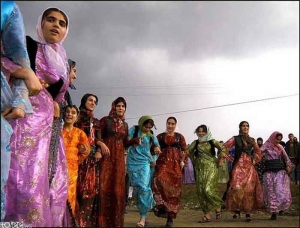
6. Baluches
The Baluch ethnicity of Iran mostly inhabits the eastern provinces such as Baluchistan, Sistan, Kerman, and Khorasan. Outside the border of Iran, they live in Balochistan in Pakistan, and Afghanistan. Like other ethnicities in Iran, they also consist of several tribes. The most famous Baluchi tribes are Ahmadzi, Mirabdi, Rigi, and Sarawani. The Baluches in Iran, like almost every ethnicity in Iran, face many challenges and difficulties, such as poverty, discrimination, marginalization, and human rights violations. They have shown resilience and courage in the face of adversity and oppression.
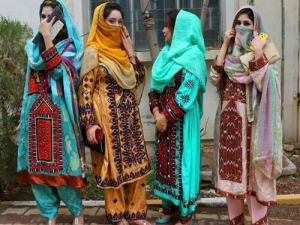
7. Arabs
The Iranian Arabs live mostly in the south of Iran and in the Khuzestan Province. Some Arabs also reside in the Persian Gulf islands. Originally, this ethnic group migrated to Iran during the Muslim Arab Conquest of Iran during the Sassanid era. Just like other ethnicities Arabs consist of several tribal and nomadic communities. Iranian Arabs have a diverse and vibrant culture that reflects their geographical and historical ties with both Iran and the Arab world. They have contributed to various fields of art, literature, music, politics, and religion in Iran and beyond.
8. Talyshi
The Talysh people are an Iranian ethnic group who live in a region that spans the South Caucasus and the southwestern shore of the Caspian Sea. They share this region with Azerbaijan and Iran and speak the Talysh
language which is one of the Northwestern Iranian languages. In Iran, the Talysh people mainly inhabit the northern regions of Gilan and Ardabil provinces, where they form a significant minority. They practice various branches of Islam, mostly Shia in Azerbaijan and mostly Sunni in Iran. They have also contributed to the arts, literature, and politics of Iran.
9. Tats
The Tats of Iran are an Iranian ethnic group that live mainly in the northern regions of the country, especially in Qazvin province. They speak the Tati language, which belongs to the northwestern branch of Iranian languages and is closely related to the Talysh language. The Tats have a long history and culture that dates back to the ancient times. They are believed to be descendants of the Old Azari language speakers who inhabited the region before the Turkic migrations.
10. Mazandaranis
The Mazandaranis are indigenous to the Caspian sea region of Iran. They are also referred to as Mazanis or Tabaris. They speak the Mazanderani language, which is a Northwestern Iranian language closely related to Gilaki. The Mazandaranis have a background in the Tabari ethnicity, and their origin goes back to Tapuri and Amardi people. Their land was called Tapuria or Tapurestan, the land of Tapuris.
11. Gilaks
Gilaks are an Iranian ethnic group native to the northern Iran province of Gilan and are one of the main ethnic groups residing in the northern part of Iran. They speak the Gilaki language, an Iranian language that is closely related to Mazandarani. They have a rich culture and history, influenced by their geographical location and interactions with other Iranian and Caucasian peoples.
What are the Main Nomadic Tribes in Iran?
The term ethnicity mostly refers to racial and cultural differences. However, within ethnicities, there are various forms such as:
- Sedentary occupations (cities, towns, and villages)
- Nomadic residencies (herders, seasonal movements, and summer and winter pastures)
While traveling to Iran, you can see not only different ethnicities across Iran but also different ways they live their life. Nomadic culture is one of the most interesting lifestyles that is still practiced in Iran. Accordingly, the main nomadic tribes of Iran that still follow the ancient tradition of their ancestors are:
1. Qashqa’I of Southwestern Iran
One of the most famous and largest nomadic groups in Iran is Qashqa’I nomads. The origin of their nomadic culture dates back to the Neolithic era in the Zagros Mountain region. That being said, they follow the most ancient traditions held by their ancestors. The Qashqa’I have been living in the Zagros Mountains and the Fars province for centuries. They migrate seasonally between their winter and summer pastures. This nomadic tribe has a strong sense of ethnic identity and prides itself on its independence and resilience. You can read more about this special nomadic group in our blog.

2. Boyar Ahmad Lur Group of the Zagros in southwestern Iran
The Lurs are one of the largest ethnic groups in Iran. They have a population of more than two million people. Lur groups live mainly in the mountainous regions of western Iran. They occupy the provinces of Lorestan, Chaharmahal and Bakhtiari, Kohgiluyeh and Boyer-Ahmad, Khuzestan, Hamadan, Isfahan, Tehran, and southern Ilam. They speak various dialects of the Luri language, which belongs to the Indo-European language family. The Boyer Ahmad Lur group is one of the four main branches of the Lurs, along with the Bakhtiari, Mamasani, and Lur proper.
They live in the province of Kohgiluyeh and Boyer-Ahmad, which is named after them. The Boyer Ahmad Lurs are divided into several subgroups. The Yasuji, Dinarani, Kordi and Zangeneh are the main subgroups of this nomadic group. They have a rich and diverse culture, with distinctive traditions, music, folklore, handicrafts and cuisine. The history of the Boyer Ahmad Lurs goes back to ancient times, when they were part of the Elamite civilization that ruled over western Iran. The Elamites were the proto-Lurs, who later adopted the Iranian language and culture under the influence ofthe Achaemenid Empire.
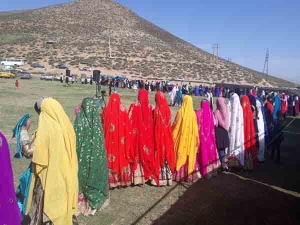
3. Bakhtiari of Luristan in Southwestern Iran
Bakhtiari nomads are another famous Lur group in Iran. They are a fascinating example of a nomadic tribe that has preserved its culture and identity for centuries. This ancient population of Iran speaks the Luri language, a branch of the Iranian languages. They mainly inhabit the Zagros Mountains, where they migrate between different pastures according to the seasons. They rely on animal husbandry, agriculture, and oak trees for their livelihood. The Bakhtiari women play a vital role in the tribe’s survival and resilience. They are known for their courage, strength, and skills. The Bakhtiari is a living testimony to the diversity and beauty of Iran’s ethnic
groups. You can read more about the Lur Ethnicity in our blog.
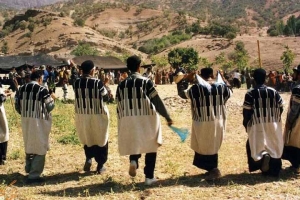
4. Shahsevan of Iranian Azerbaijan
The Shahsevan is a branch of the Turkic Oghuz groups, a sub-ethnic group of Azerbaijani people. They are located in Iran and the Republic of Azerbaijan. The name Shahsevan means “adherents of the Shah. It means people who love Shah and are devoted to the Shah”. The Shahsevan have a long and complex history that dates back to the Safavid era (1501-1736). They were formed as a confederation of various tribal groups loyal to the Safavid kings. The Shahsevan played an important role in defending the Safavid empire from external threats, especially from the Ottoman and Uzbek rivals. They also enjoyed special privileges and autonomy from the central government. The Shahsevan traditionally pursued a nomadic pastoral way of life, migrating between winter pastures in Moḡān and
summer quarters 100-200 km to the south on the Sabalān (or Savalan) and neighboring ranges, in the districts of Ardabil, Meškin, and Sarāb. They lived in distinctive hemispherical felt-covered tent-huts called alačıq. This specifically reflects their Central Asian origins. They also produced beautiful carpets, rugs, and other textiles with geometric patterns and vivid colors.
5. Baluch of the Sarhad in the southeast of Iran
The Baluch of the Sarhad is one of the two main groups of Baloch people living in Iran, along with the Makrani. The Sarhad region covers the northern part of Sistan and Baluchestan Province, bordering Afghanistan and Pakistan. The Sarhad Baluch has a distinct culture, language, and history from the Makrani people, who inhabit the coastal areas of the province. They have a tribal structure, with several clans and sub-clans that trace their ancestry to a common ancestor. One of the largest and most influential tribes in the Sarhad region is the Yarahmadzai tribe, which is divided into three smaller groups: Sohrabzai, Hossenzai, and Rahmetzai. We will talk more about the Baluch nomadic groups below.
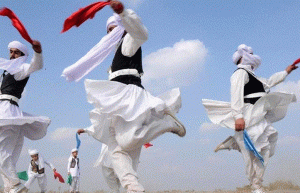
6. Shah Nawazi of Iranian Baluchistan in the Southeast of Iran
The Shah Nawazi has a rich and complex history and culture that reflects their adaptation to the harsh and diverse environment of Baluchistan. They are also known as Yarahmadzai which we mentioned above. The Shah Nawazi practices pastoral nomadism, moving their herds of sheep, goats, and camels between seasonal pastures in the highlands and lowlands of Baluchistan. They also engage in trade, agriculture, and handicrafts for their livelihood. The Shah Nawazi is an example of a resilient and dynamic people who have maintained their cultural identity and autonomy in a changing world. They offer valuable insights into the diversity and complexity of cultures in the Middle East.
7. Komachi of Kerman in Southcentral Iran
The Komachi is a fascinating group of nomadic pastoralists who live in the arid and mountainous region of Kerman Province, in south-central Iran. They have a rich and complex culture that reflects their adaptation to the harsh environment. The Komachi move seasonally between different pastures, following the availability of water and fodder for their animals. They mainly raise sheep and goats but also have some horses, donkeys, camels, and dogs. They sell their wool, meat, milk products, and skins in nearby villages, and buy grain and other necessities. The Komachi is a unique example of how a nomadic pastoral society can survive and grow in a challenging environment.
8. Basseri of Fars in southern Iran
The Basseri of Fars in southern Iran is a nomadic tribe of Persian origin who has a long history. They are one of the five tribes that make up the Khamseh confederation, which was formed in the 19th century to resist the Qajar dynasty. The Basseri are known for their pastoral lifestyle, migrating seasonally with their sheep, goats, and camels along the Zagros Mountains. They speak a dialect of Persian that contains many old words and expressions that are not found in modern Persian. The Basseri have a complex social organization based on the tent as the main unit of
production and consumption. Each tent has a head who represents the tent in dealings with other tents and authorities. The tents are grouped into clans, which are led by khans or chiefs. The Khans have power over their
clans and are responsible for maintaining relations with the government. The Basseri have a rich culture that includes oral traditions, poetry, music, dance, and rituals.
9. Yomut Turkmen of the Gorgon Plain in northeastern Iran
The Yomut Turkmen are one of the largest Turkmen tribes that live in Western and Central Asia. They have a long and rich history of nomadic pastoralism. They live in tents made of felt or cotton, called yurts, and weave carpets and rugs that are famous for their quality. The Yomut Turkmen have a complex social organization that is based on kinship, tribal affiliation, and territorial division. They are divided into four main sub-tribes: Ata, Choudor, Goklan, and Nohurli. Each sub-tribe is subdivided into clans (taypa), lineages (uruk), and families (aile). They do not have a single chief or ruler, but rather a council of elders (aksakal) who represent their clans and sub-tribes. The Yomut Turkmen also have charismatic leaders (bey) who are recognized for their wealth, generosity, bravery, or religious
knowledge. The beys act as patrons and protectors of their followers (chopan), who in turn offer them loyalty and support.
Nomadic Residencies
The nomadic lifestyle has encouraged nomads to take residency in portable houses in the form of Black Tents. These tents are also considered a part of their handicraft. The tents vary according to geographic circumstances in each part of the country. For example, Baloch’s Kapar Houses, Qashqai’s Black tents, Bakhtiari’s Behun, Sangsari’s Gut, Turkmens’ Pergola, and many more, each with their special form and elements. Handicrafts Making Handicrafts by Nomads has too been inspired by their way of living. As a result, they have to provide the needed appliances of their livelihood themselves. Among their most important handicrafts are carpets, rugs, Kilim, Jajim, Throw pillow called Poshti, and many more. There are also the world-famous Turkmen Poshti Cushion and Qashqai Gabbeh.
Distribution of Ethnic Groups in Iran
1. Ethnic Groups in West and South
They occupy the following provinces in Iran:
Kurdistan, Kermanshah, Ilam, Isfahan, Chaharmahal Bakhtiari, lorestan,
kohgiluyeh and Boyer Ahmad, Fars, Khuzestan, and Bushehr
The groups:
- Kurds: they live in the province of Azerbaijan, Kurdistan, Kermanshah, and Ilam.
- Ethnicities in Lorestan (Lur and Lak): Laks occupy the northwestern part of Lorestan while the Lurs live in Ilam, Chaharmahal Bakhtiari, Khuzestan, Markazi, kohgiluyeh and Boyer Ahmad, and a part of Fars Province.
- Qashqai Turks and Fars Khamseh: They occupy the Fars province.

2. Ethnic Groups in northwest
They occupy the following provinces in Iran:
East and west Azerbaijan and a part of Gilan Province
The groups:
- Shahsun
- Arasbaran
3. Ethnic Groups in northeast
They occupy the following provinces in Iran:
Khorasan Razavi, Northern Khorasan, Semnan, parts of Mazandaran, and
Golestan
The groups:
- Turkmen
- Kurds
- Turk
4. Ethnic Groups in east and southeast
They occupy the following provinces in Iran:
Khorasan, Sistan and Baluchestan, Kerman, and Hormozgan
The groups:
- Baloch
Experience Nomadic Lifestyle in Iran
Nomadic lifestyle dates back to prehistoric times and is as old as the Neolithic era. Iran is one of the poles of nomadism. There are still hundreds of tribes around Iran that follow this ancient culture and lifestyle. While visiting Iran, one of the most unique experiences could be living with nomadic tribes and experiencing their lifestyle. This experience in the untouched nature and environment of Iran is what your Iran travel needs and lacks. If you choose to travel with Narcis, we can arrange this experience of a lifetime for you. In this experience, you get to stay in nomadic tents, cook with them, do the things that they do on a daily basis, and more.
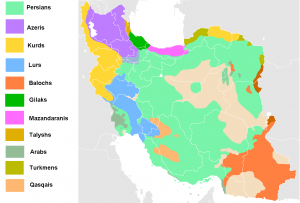

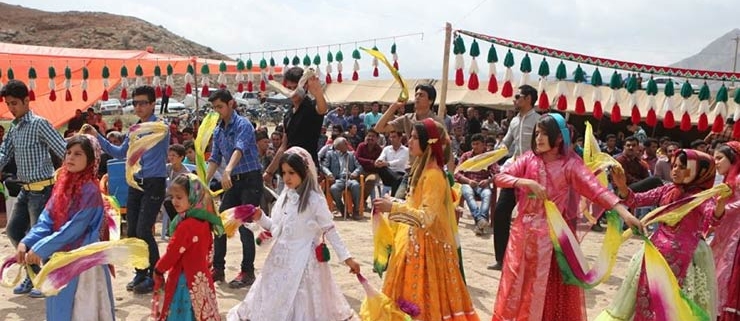
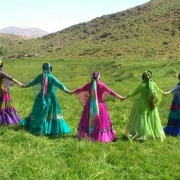
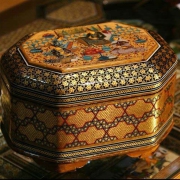
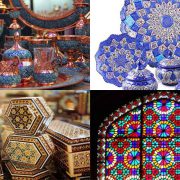
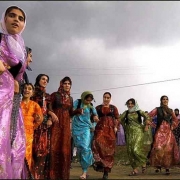
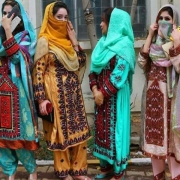
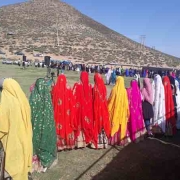
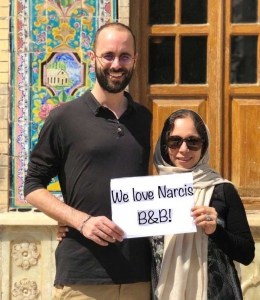




Leave a Reply
Want to join the discussion?Feel free to contribute!